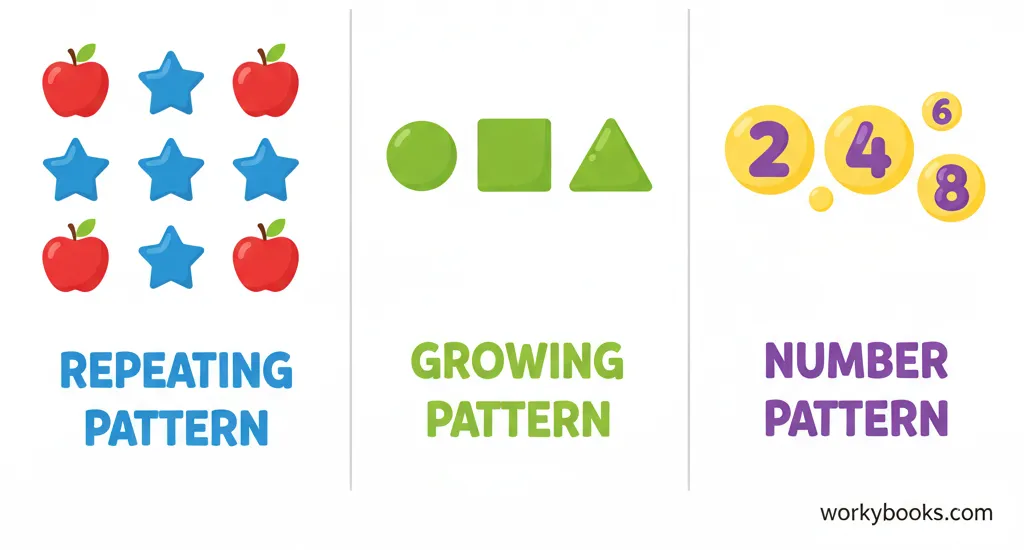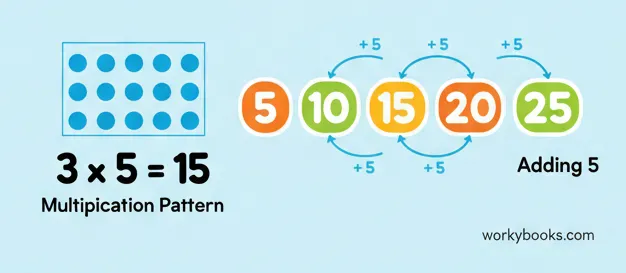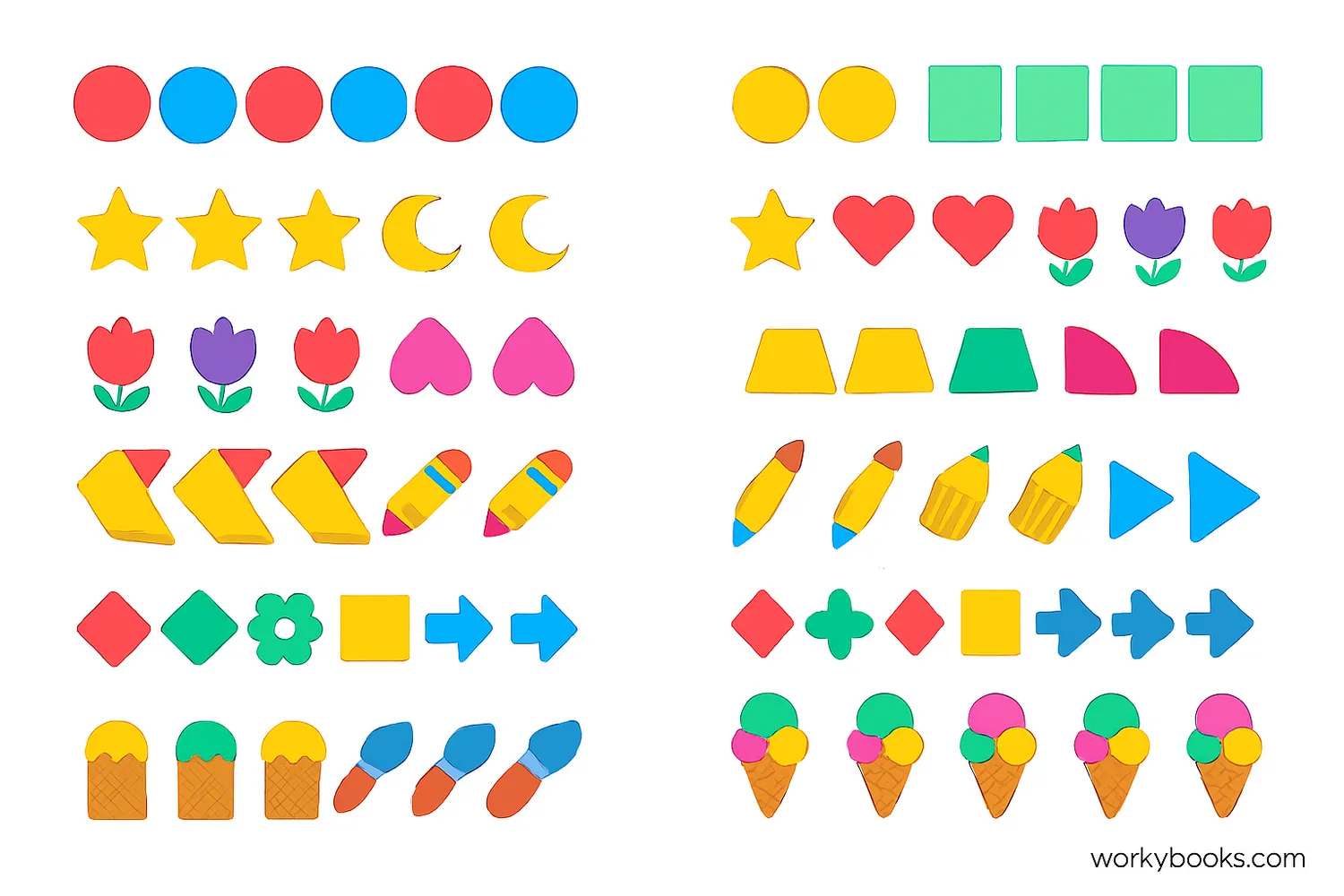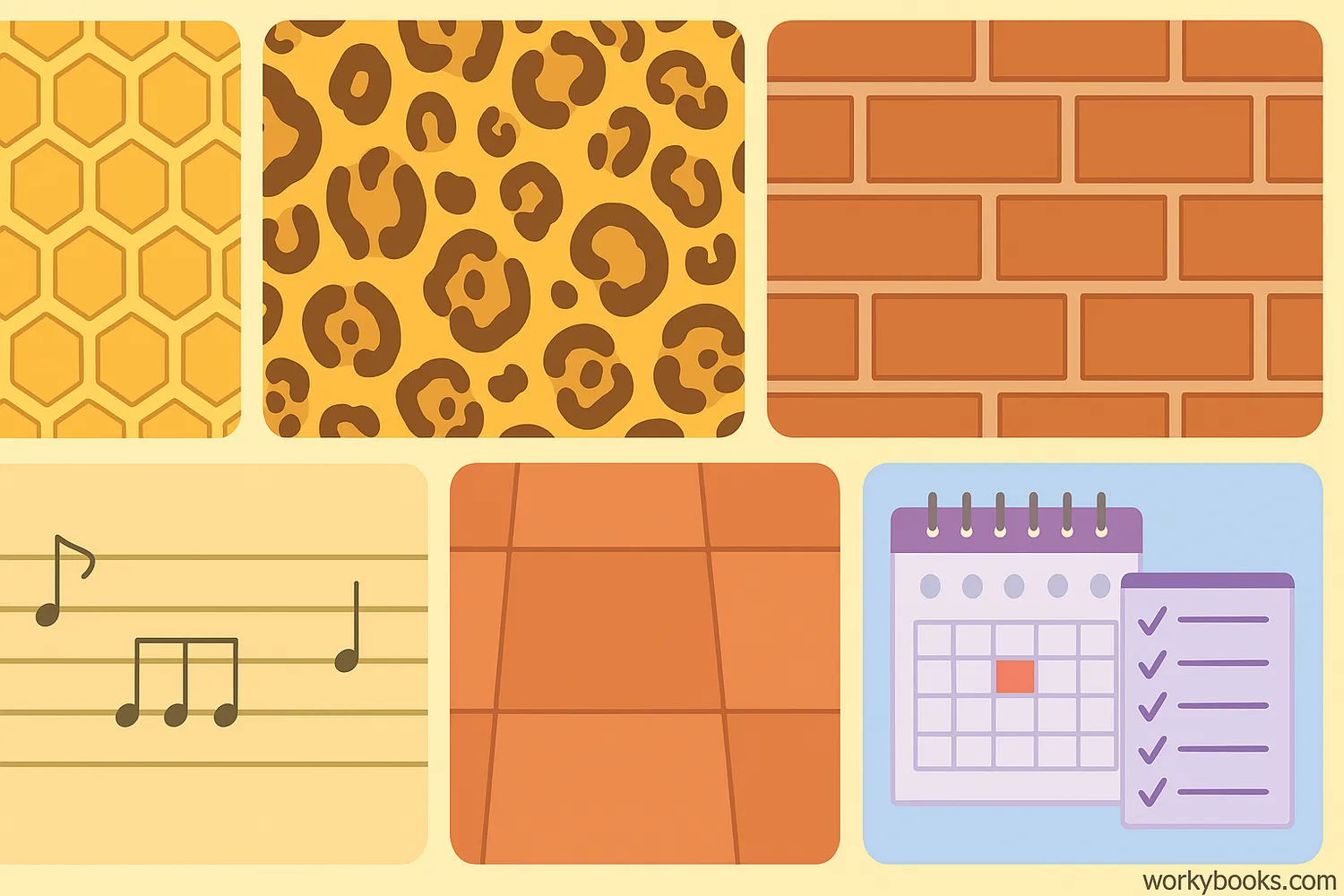Pattern - Definition, Examples, Quiz, FAQ, Trivia
Learn about patterns in math with easy explanations and practice activities
What is a Pattern?

A pattern is something that repeats in a predictable way. In math, patterns are arrangements of numbers, shapes, colors, or objects that follow a specific rule or sequence.
Patterns help us predict what comes next. When you can identify a pattern, you can figure out the rule that it follows and continue the sequence.
Why are patterns important in math?
Patterns help us:
• Recognize relationships between numbers
• Make predictions about what comes next
• Solve problems more efficiently
• Understand how math works in the real world
Key Concept
A pattern is like a secret code - once you figure out the rule, you can predict what comes next!
Types of Patterns

There are several different types of patterns in math. Let's look at the main ones:
1. Repeating Patterns: These patterns follow a sequence that repeats over and over.
Example: 🔴🔵🔴🔵🔴🔵 (red, blue, red, blue...)
2. Growing Patterns: These patterns increase or decrease in a predictable way.
Example: △, △△, △△△, △△△△ (adding one triangle each time)
3. Number Patterns: These are sequences of numbers that follow a specific rule.
Example: 2, 4, 6, 8, 10 (adding 2 each time)
4. Shape Patterns: Patterns made with different geometric shapes.
Example: □, ○, △, □, ○, △ (square, circle, triangle repeating)
Repeating Pattern
ABAB pattern
Growing Pattern
Increasing by 1
Number Pattern
Adding 5 each time
Remember
No matter what type of pattern you find, the most important thing is to identify the rule that it follows.
Number Patterns

Number patterns are sequences of numbers that follow a specific rule. Finding number patterns helps us understand how numbers relate to each other.
Common Number Patterns:
1. Counting Patterns: These follow our counting sequence.
Example: 2, 4, 6, 8, 10 (counting by 2s)
2. Addition Patterns: Each number is found by adding the same amount.
Example: 3, 7, 11, 15, 19 (adding 4 each time)
3. Multiplication Patterns: Each number is found by multiplying by the same amount.
Example: 5, 10, 20, 40, 80 (multiplying by 2 each time)
4. Subtraction Patterns: Each number is found by subtracting the same amount.
Example: 100, 90, 80, 70, 60 (subtracting 10 each time)
Addition Pattern
+3 each time
Multiplication Pattern
×2 each time
Subtraction Pattern
-5 each time
Pattern Tip
To find the rule in a number pattern, look at the difference between consecutive numbers. If the difference is the same, you have an addition or subtraction pattern!
Repeating Patterns

Repeating patterns are sequences where a set of elements repeats over and over. These are some of the first patterns that young children learn to recognize.
Common Repeating Pattern Types:
1. AB Patterns: The simplest repeating pattern with two different elements.
Example: ○□○□○□ (circle, square, circle, square...)
2. AAB Patterns: Two of the same element followed by a different one.
Example: 🔴🔴🔵🔴🔴🔵 (red, red, blue, red, red, blue...)
3. ABC Patterns: Three different elements that repeat.
Example: △○□△○□△○□ (triangle, circle, square repeating)
4. AABB Patterns: Two of one element followed by two of another.
Example: 🟡🟡🟢🟢🟡🟡🟢🟢 (yellow, yellow, green, green repeating)
AB Pattern
Alternating pattern
AAB Pattern
Two A's then one B
ABC Pattern
Three different elements
Real-World Use
Repeating patterns are everywhere! Look at stripes on clothing, tiles on a floor, or days of the week - they all follow repeating patterns.
Pattern Examples

Patterns are everywhere in our world! Let's look at some examples of patterns in different areas:
Nature Examples:
• Stripes on a zebra or tiger
• Spots on a leopard or giraffe
• Petals on a flower (often in Fibonacci sequence)
• Seasons (spring, summer, fall, winter repeating)
Math Examples:
• Multiplication tables (2,4,6,8...)
• Even numbers (2,4,6,8...)
• Odd numbers (1,3,5,7...)
• Fibonacci sequence (1,1,2,3,5,8...)
Daily Life Examples:
• Days of the week (Monday, Tuesday, Wednesday...)
• Months of the year
• Patterns on clothing (stripes, polka dots)
• Tile patterns on floors or walls
Nature Pattern
Hexagonal pattern
Math Pattern
Fibonacci sequence
Daily Life Pattern
Days of the week
Pattern Hunt
Try finding patterns around your home or school. Look at floor tiles, wallpaper, clothing, or even how books are arranged on a shelf!
Pattern Practice Quiz
Test your understanding with this 5-question quiz. Choose the correct answer for each question.
Frequently Asked Questions
Here are answers to common questions about patterns:
Math Trivia
Discover interesting facts about patterns:
Ancient Patterns
Patterns have been used in mathematics for thousands of years. Ancient civilizations like the Egyptians and Babylonians used patterns in their numbering systems and architectural designs.
Fibonacci in Nature
The Fibonacci sequence (1, 1, 2, 3, 5, 8, 13...) appears throughout nature. You can find it in the arrangement of leaves on a stem, the pattern of seeds in a sunflower, and the spiral of a nautilus shell.
Patterns in Music
Music is full of patterns! Rhythms, melodies, and chord progressions all follow patterns. Even the structure of songs (verse, chorus, verse) is a pattern.
Crystal Patterns
Crystals form in repeating geometric patterns. Snowflakes are a famous example - each snowflake has a unique six-sided pattern, but they all follow the same hexagonal structure.


